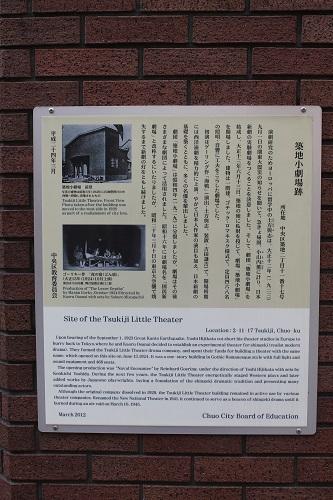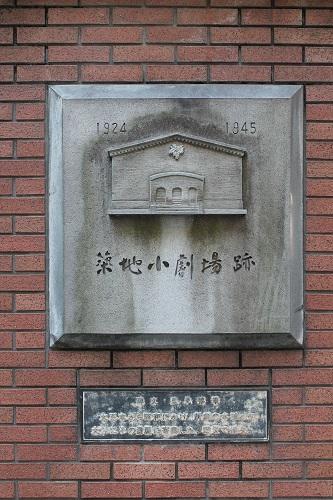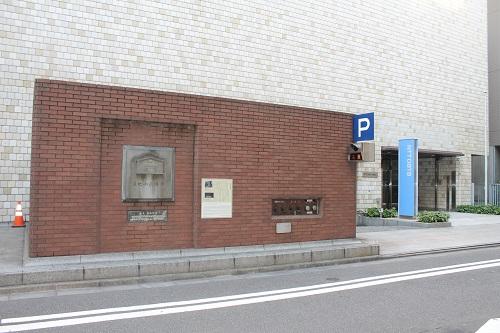List of Authors
>>About this blog
Recent blog post
|
[CAM]
September 21, 2016 18:00
In the precincts of Tsukiji Honganji Temple, there is a Peace pagoda of Shinroku Hazama, one of the Akaho Namishi who broke into Kira's residence ("Monoshiri Encyclopedia"). However, it was doubtful why only the Peace pagoda of Shinroku Hazama was located in Tsukiji Honganji. In this regard, in the January 2016 issue of the magazine "History Street", writer Shigero Ito wrote a paper entitled "The fierce stomach shown by the ninth Gishi Shinroku Hazama". It seems to be a bit difficult to obtain (not stored at the Central City Library), so I would like to introduce only the main points below.
>Speaking of Akaho Nanji's burial ground, everyone thinks of Sengakuji Temple in Minato-ku, Tokyo. After the revenge, 46 ronins except Kichiemon Terasaka, who were away from his comrades, were detained in the four daimyo Edo clan residences, and died on February 4 of the following year by the order. Each body was transported to Sengakuji Temple, the Bodaiji Temple of the Asano family in Edo, and was buried.
However, there is only one Akaho Nanji who was not sent to Sengakuji after his stomach. That was Shinroku Hazama.
>At present, six tombstones are lined up along the northeast side of the precincts of Honganji Temple. There is little to no other than those who go on a historical walk. Honganji used to have a wide grave area in the northwest, southwest of the precincts of main hall. In 1936 (1936), this cemetery was relocated to Wadabori in Suginami-ku, and at that time, a few tombstones of a celebrity were left at Tsukiji.
>The Akaho clan's residence was located here for 44 years until it was relocated from Kamisakurada to Tsukiji in 1657, and was requisitioned by the Shogunate due to Naganori's blade wound incident. Kamiyashiki, which was located in a place that encompasses the current entire St. Luke's College of Nursing and half of the site of Tate Akashi Elementary School in Chuo-ku, has a total tsubo area of more than 8,970 and a total area of the building is 3,335 tsubo. It was here that Naganori was born in 1667 (1667).
Based on these traces, the Akaho Nanji and others stopped by this land, which was the Edo Kamiyashiki of the Echizen Obama Domain after requisition to the Shogunate, and reported their achievements to the god of the land of the lord's land. .
[CAM]
August 29, 2016 18:00
Today (August 28) The theme of "Cool Japan" (NHK / BS1) at noon was "Tsukiji".
>Tsukiji Market, which is scheduled to be relocated in November. It is also introduced in the world's travel guidebook as a place where fresh seafood from all over the world gathers. At the end of such Tsukiji, a thorough survey of "What is Tsukiji loved by foreigners?" by a questionnaire to foreign tourists! Created "Tsukiji Cool Rankings Seen by Foreigners". Explore what is attractive in Tsukiji and what is different between overseas and Japanese markets.
The Tsukiji Cool Ranking was as follows.
① Sushi
② Tsukiji Fish Market
③ Hamarikyu Gardens
④ Tamagoyaki restaurant
⑤ Japanese kitchen knives shop
⑥ Tsukiji Honganji
⑦ Fruit shop
⑧ Hajime Shrine
⑨ A dry food shop
⑩ Turret (carrier)
[CAM]
August 14, 2016 14:00
In Fujio Noguchi's "Tokyo in My Nakano" (June 1978, Bungeishunshu), the evening article of the "Tokyo Shimbun" (August 16, 1977) when the monument was set up at the site of the Tsukiji Small Theater was introduced. It has been.
>From the end of the Taisho era to the Showa era, a monument commemorating the Tsukiji Small Theater (burned down in the war in 1945), which became a mecca for a new drama, was completed on the site of the theater in Tsukiji, Chuo-ku, Tokyo. About 100 people including theater and local officials gathered and the unveiling ceremony was held.
The completed monument is embedded on the wall of the Denden Corporation Building, which was built on the site of the theater, and is a relief made of Komatsu stone 1 meter long and wide. The statue of the theater before the burnout is carved and accompanied by an inscription of writer Satomi.
"Theatrical statue before burning is engraved" is strictly incorrect. The relief was sculpted at the time of its founding in 1924, and was rebuilt once in 1933. As stated on page 69 of Monoshiri Encyclopedia, the Denden Public Corporation Building has been replaced by NTT DATA Tsukiji Building.
Noguchi says, "Speaking of Tsukiji, it is immediately associated with the settlement of Akashicho, but if we were just" Tsukiji ", it was said that it was opened on June 13, 1924, when I was a first-year junior high school student, I went back to Tsukiji Koba. " At the foot of the bridge was Tsukiji Station, where Takiji Kobayashi was massacred. The front of the river is Shimbashi Enbujo, and the left hand is the East Drama. "Introducing his own sentence written in 1967.
[CAM]
August 10, 2016 09:00
Tsukiji Small Theater, as introduced on page 68 of Monoshiri Encyclopedia, is Japan's first special theater specializing in new plays, and in June 1924 (Taisho 13), Kyobashi-ku, Tokyo (currently Chuo-ku) It opened a new building at Tsukiji 2-chome.
Kafu Nagai wrote in "Shokutei Nijo" on June 23, 1924 (Taisho 13) as follows (it is not included in Iwanami Bunko's "Picking").
>Walk through Ginza to bring prosperity at night and go to Tsukiji. The Tsukiji Small Theater was built in a corner of the ruins of the Huyama residence. It is the place managed by Mr. Kaoruji Hijikata Koyamauchi. There is something like an activity photo studio next to it, but it is not known in the middle of the night. After the earthquake, Mr. Huyama's mansion was densely populated, and Shiga now has a row of buildings like a warehouse, and it has become a place where you can see it. After the garden, when I lived there, I looked at the garden, and the branches and the autumn of the garden. In addition, the loquat has been scrutinized, such as the winter sunya, who comes to birds with trees. The child is now dead. Everyone's books, such as the late Uguisu, by Niwako, were written at Tsukiji's house. If you think about such things, you can't stand the feeling of Kura ( radical) mulberry.
The following is the current figure. There is nothing that can extend the time of 1924.



[CAM]
August 6, 2016 12:00
> A type that introduces the poop of history and culture is often found in Oyado correspondent guides. If you start with this, it will be a boring guide, but ... but I want to prepare a novel story that attracts the interest of customers without just giving lectures!
As a Jijii correspondent, blogs also specialize in the "History and Culture" genre (laughs).
The other day, at the Tsukiji Social Education Center, I heard a lecture by an expert instead of a guide on "Edo", but it was a little different from what I was looking for.
There are more than 260 years from the establishment of the Shogunate (1603) to the reign of the Great Government (1867) during the Edo period. It has been more than 30 years since the drafting of the American Constitution (1787). And Chuo-ku is the original Edo, and in the United States, it is like the first 13 states. It would have been nice if the lecture was based on such circumstances.
>The other day, I participated in a “on-the-job training” that attracted particularly excellent correspondents.
I didn't have the courage to apply because I was not confident that I could provide "new stories that attract customers' interest."
I wanted to make the most of the qualifications of an interpreter guide (English), and the other day, when I applied for a training in Chuo-ku listed in the ward bulletin, I was suddenly out of the lottery.
There is no way to win a treasure if it is out of such a lottery.
[CAM]
August 3, 2016 14:00
Earlier, Yasaburo Ikeda stated in Nihonbashi's private diary as follows, stating that the name "Nihonbashi" was originally the basis for the claim that it was "Nihonbashi" at the beginning. I wrote.
>The book "One Purple (Hitomoto)" states, "What happened to Hitotsubashi, Nihonbashi (Nihonbashi) and there was no Sanbonbashi?" Nihonbashi was originally "Nihonbashi" in the background of what was written as "Gigo", but it is no confusing to see that the "knowledge" of the streets that people still knew was hidden that someday it became Nihonbashi due to the same sound association. (50)
I discovered that this "Purple One" was included in the 82nd volume of "The Complete Works of Japanese Classical Literature" (Shogakukan), "The Early Modern Ages" (published in 2000), so I would like to introduce the original text etc. .
"Purple One" is an epic of Edo's geology written by Mosui Toda, a Japanese scholar of the early modern era. Mosui Toda died at the age of 78 in 1706 (1706). According to the book, this book was established in 1682 (1682). It is a description of Edo's famous places for each category of scenic spots such as visiting castles, ancient castles, mountains, slopes, etc., and each is described in length and length. Mosui Toda seems to have been particularly interested in place names in Waka.
In this context, Nihonbashi is described as follows.
>"Hitotsubashi, Nihonbashi, what is Mitsuhashi's absence?" ... "Ichiishi Bridge, Ryogoku Bridge is like a bridge without Mitsuishi Bridge" ... ... If you touch it, from one stone, Nihonbashi Edobashi and Nihonbashiya ...
(If you count, Nihonbashi is the second from Ichiishibashi in the west, and the second from Edobashi in the east, and it is indeed a reasonable name.)
I think Mr. Yasaburo Ikeda's claim is quite persuasive.
|
Links
|

